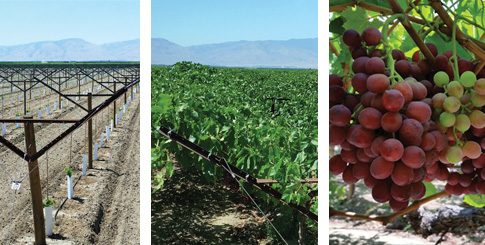Other unique types of grapes popular with consumers include Champagne or Corinth grapes (the smallest of the seedless varieties about the size of a pea) and Witch Finger grapes, which are slender and elongated with a tip (similar to the shape of a chili pepper), and get a boost in sales near Halloween.
Louie Galvan, director at Fruit Royale, Inc. in Delano, applauds the notion. He believes “new and proprietary varieties are an exciting addition to the landscape and will continue to increase exponentially at a feverish pace.”
Better Taste, Longer Season or Higher Yields?
Ford highlights the change over the past five years with Thompsons, typically the primary later season green grape, being replaced with newer varieties that hold up longer, offer better yields, and are easier to grow. However, he sees this as two-sided: while pulling out Thompsons is beneficial to growers, he believes not all of the newer grapes live up to the flavor.
It’s an interesting and complicated tug of war between producing the best flavors, while extending the season and increasing yields. Lucas explains that with the removal of some Thompson and Princess vines, growers have made room for Thomchords, a hybrid of the Thompson; Magentas, a red seedless; and the Sheegene 21, an exciting new green seedless variety that hasn’t been given an official name yet.
“It’s a much more dynamic industry,” comments Bedwell. “Previously, growers may have planted a vine and lived with it for 30 or 40 years, but the expectation now is for changes to occur in shorter periods, to react to markets and what’s happening in the world. Everyone is more aware of the dynamic nature of varietal development.”
Technology Trends
Technology continues to impact the industry from trellis systems and canopy management to cross-breeding for size and flavor.
A new technology for out in the field comes from Bird Control US, part of the Bird Control Group in Europe, which sells a device that lives up to its name. Developed in the Netherlands, laser equipment is placed in vineyards or orchards to scare away birds. The technology is customized for each customer, says Jamie Warwick, and creates what the birds consider an ‘unsafe’ zone, forcing them to change their habits and relocate. “This alleviates crop loss and avian influences,” he contends.
The technology is also used in the oil and recreation industries, causes no harm to humans or birds, and has even been endorsed by the World Wildlife Federation. “It’s a single laser,” Warwick explains, “an inch in diameter, which can travel up to 2,000 meters.” Despite success in Europe, Americans are slower to adopt the new technology. “The biggest competitor is skepticism,” he adds, due no doubt to past “failed solutions and wasted dollars.”
The Negatives
Lacking Steady Labor
California’s persisting dry weather and labor issues (both the dearth of workers and the laborious harvesting process) present hurdles for the table grape industry. “California has the optimal climate for table grapes,” says Justin Bedwell, managing member of Bari Produce, LLC in Madera. “However, if the challenges don’t get resolved, I would expect some growers to look at other crops to plant in place of table grapes.”



